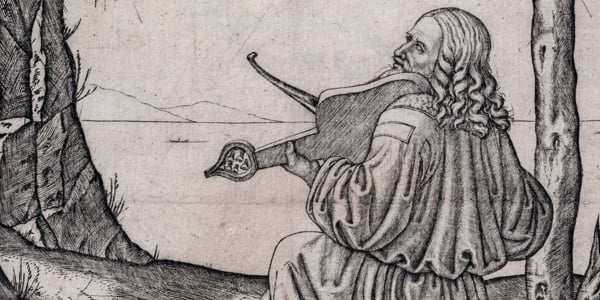
Marcantonio Raimondi’s 1505 engraving may show Leonardo da Vinci playing an instrument called a lira da braccio.
Photo: courtesy Cleveland Museum of Art.
A new portrait of Leonardo da Vinci has been identified in a 500-year-old engraving by a music professor. If verified, the image will be only the third known portrait of the Renaissance Master created during his lifetime.
“This is serious and stands some chance of being right,” said Leonardo scholar Martin Kemp, an professor emeritus of art history at Oxford University who has written several books about Leonardo, in an e-mail to Live Science.
The engraving, created by Marcantonio Raimondi in 1505, has belonged to the Cleveland Museum of Art since the 1930s, but the figure in question, seen playing an instrument called the lira da braccio, was long thought by scholars to depict the Greek mythological figure of Orpheus, a prophet and musician.
Now, Ross Duffin, a music professor at Cleveland’s Case Western Reserve University, has thrown that identification into question in an article for Cleveland Art magazine. Where Orpheus is traditionally depicted as a clean-shaven youth, the musician in the drawing is in his “late middle age, with a beard and centrally parted hair with long curls,” Duffin wrote.
Leonardo Da Vinci, Portrait of an elderly man (1512)
Photo via: Wikipedia
Until five years ago, there was only one known self-portrait of the artist, drawn in 1512 (see Why Was Da Vinci’s Self-portrait Hidden from Hitler?). A red chalk drawing of Leonardo was discovered in his Flight of Birds codex (see Newly Discovered Leonardo da Vinci Portrait on Display at the College of William and Mary).
In 1505, da Vinci would have been in his early 50s, and the drawing closely resembles a known portrait of Leonardo by Francisco Melzi created around the same time. Most importantly, Leonardo is also known to have played the lira da braccio.
Leonardo da Vinci’s self portrait.Photo: courtesy Muscarelle Museum of Art
“Leonardo was led in great repute to the Duke of Milan, who took much delight in the sound of the lira, so that he might play it,” art historian Giorgio Vasari wrote in 1550. “And Leonardo brought with him that instrument which he had made with his own hands, in great part of silver, in order that the harmony might be of greater volume and more sonorous in tone, with which he surpassed all the musicians who had come together there to play.”
Duffin speculates that Raimondi may have met Leonardo in Milan in 1506-1507 during a production of Orfeo, based on the myth of Orpheus.
Kempt isn’t entirely sold on that theory: “At this stage, I would say that it is temptingly possible but unproven.”